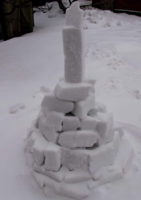 Last night I had 2 hours of time and a great desire to spend this time outdoors. So instead of going home and scribbling another blog post, I took my regular garden saw and went outside to build an igloo. The igloo is the dwelling of the Eskimos, a round house made of snow, and, as it seemed to me, the eighth wonder of the world.
Last night I had 2 hours of time and a great desire to spend this time outdoors. So instead of going home and scribbling another blog post, I took my regular garden saw and went outside to build an igloo. The igloo is the dwelling of the Eskimos, a round house made of snow, and, as it seemed to me, the eighth wonder of the world.
A digression.
 About 10 years ago, I enthusiastically read books dedicated to survival. How to get water in the desert, fire in the swamp, food in McBurgers and shelter in the tundra. By the way, one of the consequences of this survival-reading was my passion for hiking. A lot of books were read, but only a small fraction of the information received was tested in practice. I did not make fire by friction, I did not look for moss in the north, and I did not build an igloo until yesterday.
About 10 years ago, I enthusiastically read books dedicated to survival. How to get water in the desert, fire in the swamp, food in McBurgers and shelter in the tundra. By the way, one of the consequences of this survival-reading was my passion for hiking. A lot of books were read, but only a small fraction of the information received was tested in practice. I did not make fire by friction, I did not look for moss in the north, and I did not build an igloo until yesterday.
Impressions of practice.
This article is in no way educational material. I have nothing to teach yet. But I really want to share the main discovery of the evening – it is worth starting to DO something, and you will grow smarter before our eyes.The first steps were simple, I began to cut the snow under my feet. The thickness of the layer is only 20 centimeters. Drinking is easy. It is difficult to dig out the first brick. It’s easier to gouge it and immediately proceed to extracting the second brick. Starting from the second row, sawing out bricks became quite simple.It took me 30 minutes to make 10 bricks about 40*30*15 in size! It turned out that ten of these bricks can be folded into a circle with a diameter of a little less than a meter. So be it. Let’s build a puppet shelter.Due to the large curvature of the wall (compared to the size of the brick), in order to obtain tight joints, it was necessary to cut the corners heavily. Therefore, I initially began to make the second batch of snow blocks trapezoidal. Installing the second row of blocks, I suddenly remembered what was written in the survival book. Bricks should not be laid out in even horizontal layers, but in a spiral (like a snail). It took another half an hour to make the height difference of the first orbit smooth.But then everything went like clockwork. I made trapezoidal blocks, laid them in a spiral, and already on the fourth row the walls began to converge towards the center – a real dome was obtained. Soon I was laying the last – horizontal slab. The construction turned out to be tiny, and in order to give it solidity, I put a vertical snow column on the roof.It was already completely dark, my legs were damn cold, it was time to hide in the house. In the morning I took a photo and
Installing the second row of blocks, I suddenly remembered what was written in the survival book. Bricks should not be laid out in even horizontal layers, but in a spiral (like a snail). It took another half an hour to make the height difference of the first orbit smooth.But then everything went like clockwork. I made trapezoidal blocks, laid them in a spiral, and already on the fourth row the walls began to converge towards the center – a real dome was obtained. Soon I was laying the last – horizontal slab. The construction turned out to be tiny, and in order to give it solidity, I put a vertical snow column on the roof.It was already completely dark, my legs were damn cold, it was time to hide in the house. In the morning I took a photo and  considered his work well. Crooked rows, huge holes, a clear waste of material, many other shortcomings. Solid shortcomings.But they all overlap with one huge advantage. Practical experience was gained, a real skill. Somehow I’m sure the next igloo will be built better and faster. I’m currently rereading the snowmaking manual from a survival book. Now, after experimenting on my own, I understand better what the author is talking about. God, what a good fellow I am :)
considered his work well. Crooked rows, huge holes, a clear waste of material, many other shortcomings. Solid shortcomings.But they all overlap with one huge advantage. Practical experience was gained, a real skill. Somehow I’m sure the next igloo will be built better and faster. I’m currently rereading the snowmaking manual from a survival book. Now, after experimenting on my own, I understand better what the author is talking about. God, what a good fellow I am :)
Some statistics
It took about 40 bricks to build this little igloo. They were mined in a 3 square meter snow pit. The total height of the structure (with a column) is 160 centimeters.P.S. A couple of days later, I made a second, larger attempt build an igloo .
